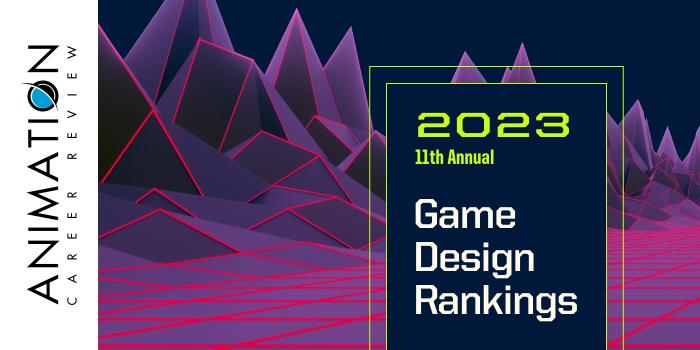
Turn your passion for drawing into a career in film and games with CG Spectrum. Courses include personalized mentorship from award-winning concept artists, career services, and access to a supportive community. Learn more.

| Ranking | School | City |
|---|---|---|
| 1 | University of Southern California | Los Angeles |
| 2 | University of California, Santa Cruz | Santa Cruz |
| 3 | Gnomon School of Visual Effects | Hollywood |
| 4 | University of California, Los Angeles | Los Angeles |
| 5 | University of California, Irvine | Irvine |
| 6 | Laguna College of Art and Design | Laguna Beach |
| 7 | Academy of Art University | San Francisco |
| 8 | California Polytechnic State University | San Luis Obispo |
| 9 | ArtCenter College of Design | Pasadena |
| 10 | Otis College of Art and Design | Los Angeles |
Our 2023 ranking of the top game design school programs in California. For an explanation of the ranking criteria, click here.

University of Southern California (USC) has launched two new programs for the 2022-2023 school year. Housed in the School of Cinematic Arts (SCA), the new Game Art BFA provides the opportunity to specialize in areas such as Character Animation, Visual Effects (VFX), Interactive Animation, 3D Pipelines, or Environmental Design.
Consisting of 128 units, the new cross-disciplinary Game Art BFA features 52 units in the major, five workshop courses, the opportunity to select six elective credits in areas from character rigging to Python, and an Advanced Game Project (AGP). Completed in teams across two courses, the AGP culminates with a functional digital game suitable for distribution via the web and/or submission into independent games festivals.
Housed in Viterbi School of Engineering, the new Technical Game Art (TGA) Minor is part of the Information Technology Program (ITP). Students in the program will complete 16 units of study, several projects, and courses such as 3D Character Modeling for Games, Technical Character Animation for Games, and 3D Modeling, Animation, and Visual Effects (VFX). Elective examples include Accelerated Programming in Python, and 3D Computer Animation.
In addition to two new programs for students interested in pursuing game studies, University of Southern California houses USC Games—a collection of minors and multiple degree programs leading to a BA, BFA, BS, MFA or MS. Programs are part of SCA’s Interactive Media and Games Division and the Department of Computer Science at Viterbi School of Engineering.
The USC Games Program combines the study of art, design, engineering, and production. Classes are collaborative, immersive, and hands on, allowing students to develop team-building skills and expertise in every area of game design and development. Courses are taught by working professionals in the field.
Specific degrees include an Interactive Entertainment BA, a Game Development and Interactive Design BFA, a Computer Science BS (Games), MFAs in Interactive Media (Games and Interactive Entertainment) and Interactive Media (Games and Health), a Game Design and Development MS, and a Computer Science MS with a Game Development Specialization. A Cinematic Art MA (Media Arts, Games and Health) is offered in conjunction with SCA, the Graduate School, and the Creative Media & Behavioral Health Center.
Minors within the USC Games Program are designed for students who would like to develop entry-level game design and development skills that can be utilized in interactive media, animation, games, film/television, and other areas. Course examples across Minors include Game Design, Game Animation, Game Studies, Video Game Design and Management, Game Audio, Game Entrepreneurism, Video Game Programming, Game User Research, Video Game Production, 3D Computer Modeling and Graphics, Computer Science, and Themed Entertainment.
Graduates of USC Games have developed and sold their own games, launched their own studios, or landed positions at major studios such as Riot Games, Disney, Epic Games, Apple, ESPN, and CBS interactive.
Established in 1880, University of Southern California (USC) employs more than 28,100 people making it the largest private sector employer in Los Angeles. Serving 49,500 students across 23 schools and divisions, USC is also one of the largest research universities in the U.S. More than 600 graduate and professional programs are offered, including one of the best film programs in the nation. USC is the only university to have an alum nominated for an Oscar every year since the Academy Awards’ inception in 1929.
The University of Southern California is accredited by the Western Association of Schools and Colleges (WASC) Senior College and University Commission (WSCUC).

University of California, Santa Cruz (UC Santa Cruz or UCSC) was the first institution in the University of California System to launch an undergraduate game major. Housed in the Jack Baskin School of Engineering (BSOE), and known as Games @ UC Santa Cruz, this intensive program has expanded to include three advanced degree programs including the MFA, MS, and PhD.
Programs are available at the UC Santa Cruz and Silicon Valley campuses and include Computer Science: Computer Game Design (BS), Art & Design: Games and Playable Media (BA AGPM), Digital Arts and New Media (MFA), Serious Games, Computational Media, and Games and Playable Media (MS degrees), and Computational Media (PhD).
Students in all programs have access to Games @ UC Santa Cruz facilities and centers such as The Center for Computational Experience, Advanced Visualization and Interactive Systems, Ludo Lab, Critical Realities Studio, Software Introspection Laboratory, Expressive Intelligence Studio, ADL (Augmented Design Laboratory), Social Emotional Technology Lab, and The Other Lab.
Other program benefits include game design internships, frequent studio tours, and participation in the Annual Games Showcase. Undergraduates will complete a Capstone Project during the final year of the program and graduate students will complete a Thesis Project, Research Project, or both.
Graduates of the UC Santa Cruz Game Design Programs are prepared to pursue positions such as Game Designer, Game Writer, Digital Artist, Board Game Designer, Producer, VR/AR Artist, and 2D/3D Artist. Program alumni have been hired at companies and studios such as Electronic Arts (EA), Tic Toc Games, Method Studios, Ubisoft, Tencent, Amazon, Universal, Google, TopGolf, and Hi-Rez Studios.
University of California, Santa Cruz is accredited by the Western Association of Schools and Colleges (WASC) Senior College and University Commission (WSCUC). Established in 1965, University of California, Santa Cruz serves approximately 18,980 students, enrolled in more than 130 programs across 10 colleges and the Graduate Division.

Gnomon School of Visual Effects (Gnomon) emphasizes hands-on production. Learning takes place in classrooms that replicate real production studios. Consisting of a 30,000 square foot facility, Gnomon also houses nine state-of-the-art computer labs, drawing studios, lecture spaces, cycloramas, dedicated sculpture labs, a green screen stage, and the Gnomon Gallery.
Program options include the 180-unit Digital Production BFA and the 147-unit Digital Production Certificate. More than 35 ten-week courses for game designers are also available. Examples include Game Creation, Props and Weapons for Games, Dynamic Effects, Maya Modules, Character Rigging for Production, and Creature Animation.
The Gnomon Digital Production BFA focuses on the 3D production pipeline for visual effects, games, and film. Students will also master industry software and tools such as Nuke, After Effects, Maya, V-Ray, ZBrush, and Photoshop. A wide variety of elective options allows BFA students to create a specialization in any area of entertainment or production. Gnomon BFA students may also choose from three concentrations including 3D Generalist, Game Art, and Visual Effects.
The Digital Production BFA at Gnomon School of Visual Effects takes four years to complete (full-time), with or without a concentration. Students will graduate with a professional demo reel.
The Digital Production Certificate Program has five areas of study including Game Art, Visual Effects Animation, Modeling & Texturing, 3D Generalist, and Character and Creature Animation. The Gnomon Digital Production Certificate Program culminates in the creation of a professional demo reel. Students can complete the program in two years, full-time.
Gnomon School of Visual Effects alumni work at some of the world’s top studios. Examples include Blizzard Entertainment, Amazon Games, Framestore, WetaFX, Walt Disney Animation Studios, Pixomondo (PXO), Marvel, Industrial Light & Magic (ILM), Disney Imagineering, DreamWorks, Electronic Arts (EA), and Riot Games.
Located in Hollywood, California, Gnomon School of Visual Effects sits on a 35,000 square foot lot within the historic Television Center Studio lot. Established in 1997, Gnomon offers degree and vocational certificate programs, as well as over 100 individual 10-week courses. Gnomon School of Visual Effects is accredited by the Accrediting Commission of Career Schools and Colleges (ACCSC).

University of California Los Angeles (UCLA) is home to UCLA Game Lab and UCLA Extension. Supported by the School of the Arts and Architecture (UCLA Arts) and the School of Theater, Film and Television, UCLA Game Lab hosts visiting artists and researchers, guest speaker events, and workshops. The Lab is also supported by sponsors such as Unity, HP, Zbrush, Oculus, Nvidia, and the National Endowment for the Arts.
While UCLA Extension does not have a formal Game Design Program, it offers a number of game design courses such as Developing Video Game Narratives, Unity: 3D Game Design and Game Engines, Composing Music for Video Games, Producing Commercials for Games, and 3D Real-Time Animation.
Also housed in the School of the Arts and Architecture at UCLA is the Department of Design Media Arts (DMA), which has several multidisciplinary programs suitable for students interested in game design. Options include BA and MFA degrees in DMA (BA DMA, MFA DMA). The undergraduate program explores everything from interactivity and motion to video and game design. Courses for the program are taught as studios of up to 22 students. Course examples for the program include 3D Modeling and Motion, Game Design, Tangible Media, Word + Image, and Video.
DMA BFA students will complete a final project (the Senior Project) in Interactivity and Games, Video and Animation, or Visual Communication and Image.
The two-year UCLA Digital Media Arts MFA requires a full year of thesis work. Students will work and learn through seminar and studio courses. All MFA students will have the opportunity to collaborate with instructors on research projects or work as teaching assistants. The MFA DMA culminates in an MFA Exhibition.
Graduates of the Game Design Programs at UCLA work in all areas of game design and development at local, national, and global game design studios, software companies, production studios, and more.
Established in 1919, University of California Los Angeles has played a pivotal role in the formation of nearly 200 startup companies. Serving 45,900 students from 118 countries, UCLA offers more than 250 programs across 12 professional schools and UCLA College. University of California Los Angeles is accredited by the Western Association of Schools and Colleges (WASC) Senior College and University Commission (WSCUC).

The Donald Bren School of Information & Computer Sciences at University of California, Irvine (UC Irvine or UCI) has several paths to study game design. The Department of Informatics houses the Game Design and Interactive Media (GDIM) Program, which leads to a BS. The Department of Computer Sciences has a Computer Game Science BS, and BS, MS, and PhD degrees in Computer Science.
The GDIM BS consists of hands-on courses that explore areas such game programming, game design and development, game studies, interactive storytelling, visual design, and data science, as well as emerging technologies such as tabletop and mobile games, and AR/VR. During the junior and senior years of the program, students will have the opportunity to build a professional portfolio through advanced electives that explore game design, development, and programming, game culture, storytelling, and games entrepreneurship. UCI GDIM BS culminates with a two-quarter capstone project. Students will complete the capstone under the guidance of industry mentors.
Graduates of the UC Irvine GDIM Program are Game Designers, Game Programmers, Game Developers, Game Artists, Project Managers, and Interactive Media Designers, among others. Some program alumni have busy freelance careers, while others have launched their own studios. Potential employers include industry partners such as Electronic Arts (EA), Blizzard Entertainment, Riot games, Obsidian Entertainment, Disney, Cartoon Network, and Tencent.
The Computer Game Science BS (CGS BS)explores games (game engines, games and society, multiplayer games, and game design), computer science (graphics, artificial intelligence, programming, and data structures), and math (linear algebra, statistics, and logic). Students in this program have the opportunity to specialize in just about any area through thirty required elective credits. They will also have the chance to work in teams to build games for entertainment, education, training, healthcare, and more.
Graduates of the UC Irvine Computer Game Science BS are employed in the games industry (for entertainment) as well as serious games in areas such as healthcare, education, and training. Some CGS BS graduates go on to enroll in advanced study in game design, interactive media, and other related areas at top graduate schools.
The Computer Science BS at UCI has a Specialization in Algorithms that focus on techniques in computer games, graphics, computer vision, artificial intelligence (AI), and other areas. The graduate Computer Science Programs feature multimedia and gaming, programming languages and compilers, scientific computing, and AI and machine learning research areas, among others.
Across programs, students have access to courses such as Game Engine Lab, Modeling and Worldbuilding, Game Design, Mobile and Ubiquitous Games, Python, Advanced 3D Computer Graphics, Virtual Reality, Internet of Things (IoT) Software and Systems, Visual Computing, Programming Languages, and Multimedia Systems and Applications.
Graduates of the Computer Science Programs at UC Irvine are prepared to pursue positions in virtually every area of science, technology, and business. Examples include Games, Entertainment, Software Engineering, Aerospace, Business Information Management, Biomedical, Finance, National Defense, Cybersecurity, Data Science, and Engineering.
University of California, Irvine is accredited by the Western Association of Schools and Colleges (WASC) Senior College and University Commission (WSCUC). With more than 1,200 faculty members and 10,000 staff, UC Irvine is the largest employer in Orange County California. Established in 1965, the school serves approximately 37,245 students enrolled in more than 220 programs across 18 colleges, schools, and divisions.

Laguna College of Art and Design (LCAD) has several programs for game designers including a Game Art BFA, a Game Design MFA, and an Entertainment Design Minor that explores topics such as environment, character, prop design, and storyboarding. Entertainment Design students will create several creative works that can be used to begin building a professional portfolio.
In all programs, students will work and learn in a project-based environment that encourages collaboration. Course examples across programs include Advanced Drawing for Games, 3D Environmental Design, UI/UX for Games, Pictorial Design for Illustration, Rigging and Animation for Games, 3D Design (Intro to Zbrush), Scripting for Games, Creatures and Characters, World Development, Concept Design for Entertainment, Storyboarding for Entertainment – Live Action Film, Development Team New Technologies, Fundamentals of Maya, and Visual Storytelling for Entertainment.
Game Art BFA students will work in teams with graduate MFA students to create industry-ready games that could be featured at the Independent Game Festival (IGF). Students will also participate in workshops led by artists and designers such as Bill Perkins, Justin Thavirat, and Chris Bateman.
The Game Design MFA at Laguna College of Art and Design Game Design is a two-year, terminal degree that leads to the creation of a final, marketable game. Courses explore areas such as game prototypes, game mechanics, game narrative, the game production cycle, game design processes, and the business of games.
Graduates of the Game Art and Game Design Programs at LCAD are employed at major companies and studios around the globe. Examples include Riot Games, DreamWorks, The Jim Henson Company, Insomniac Games, Disney Animation Studios, Blizzard Entertainment 20th Century Fox, Sony Interactive Entertainment, Microsoft Studios, Obsidian Entertainment, and Marvel.
Founded in 1961, Laguna College of Art and Design began as Laguna Beach School of Art (LBSA). In addition to the main campus in Laguna Beach, LCAD has educational affiliates locally and around the world including Florence Academy of Arts in Florence, Italy, Los Angeles Academy of Figurative Art, and NHTV Breda University of Applied Sciences (NHTV), Netherlands.
Laguna College of Art and Design serves around 770 students enrolled in dozens of degree and minor programs. The school is regionally and nationally accredited by the Western Association of Schools and Colleges (WASC) Senior College and University Commission (WSCUC) and the National Association of Schools of Art and Design (NASAD).

Academy of Art University (Academy of Art) is home to a STEM-certified School of Game Development that operates under the direction of professionals who are active in the game design industry. Program options include AA, BFA, MA, and MFA degrees in Game Development, a BS in Game Programming, and BFA degrees in Game Design, Concept Art, and 3D Art.
Academy of Art programs are multidisciplinary, so student designers will explore game systems and tools programming; coding; augmented and virtual reality (AR/VR); rigging; animation/animation VFX; artificial intelligence (AI); concept art; user interface/user experience (UI/UX) design; 3D modeling; technical art; and level design.
Across programs, students will take courses such as Programming for Games, AI, Mobile Game Development, Programming for Game UI and Tools, Game Engines, History of Gaming, Collaborative Game Development, 2D Tools for Game Development, Game Engines, 3D Modeling for Games, Prop & Weapon Design for Games, Level Design for Video Games, Rapid Game Development, Combat Design, and Game Freemium & Monetization.
Partnerships with studios such as Zynga, Sony Interactive Entertainment, and Riot Games allow School of Game Development students to gain real-world experience through professional internships. In addition to working at a top studio prior to graduation, students will engage in hands-on learning in the Academy of Art Game Development Studio. Examples of facilities and technology include cross-departmental war rooms with students from the Schools of Animation, Illustration, and Music, among others, Xbox/PlayStation/Nintendo Game consoles, competitive esports lab, 280+ Alienware High Performance Computers with Dual Monitors, AR/VR labs, and the Game Lounge.
Graduates of the School of Game Development at Academy of Art University have been recruited by major studios such as Riot Games, Zynga, and Sony Interactive Entertainment. Students have also been hired at Sledgehammer Games, Naughty Dog, and Crystal Dynamics.
Academy of Art University is a family-owned private university located in San Francisco—one of the world’s top cities for animation careers. Established in 1929 and serving more than 7,000 students, Academy of Art is one of the nation’s largest private art and design schools. Divided into 22 schools, Academy of Art University offers more than 129 degree programs in 40+ areas of study. Programs lead to the AA, BA, BFA, BS, B. Arch, MAT, MA, MFA and M. Arch degrees.
The Academy is accredited by the Western Association of Schools and Colleges (WASC) Senior College and University Commission (WSCUC).

The College of Engineering (CENG) at California Polytechnic State University (Cal Poly) is home to the Department of Computer Science and Software Engineering, which has several pathways to study game design. All CENG programs provide hands-on learning in a studio-like, collaborative environment that focuses on design- and project-centered coursework.
Degree options include the BS, MS, and Blended BS + MS in Computer Science. Minor options include Computer Science and Computing for Interactive Arts. The CS Minor allows students to specialize in Game Development through electives. The Computing for Interactive Arts Minor is a cross-disciplinary, 40-unit program offered in partnership with the Department of Art and Design in the College of Liberal Arts. MS and Blended BS + MS CS students may specialize in multiple areas or enroll in the Game Development Concentration.
Consisting of 24 credit hours, the Game Development Concentration requires the Video Games & Society, Game Design, Introduction to Mixed Reality, and Interactive Entertainment Engineering courses. Students may choose four credits from Mathematics/Statistics electives and the remaining credits from a variety of areas and to suit their goals. Examples of M/S electives include Game Theory, Introduction to Probability and Simulation, Design and Analysis of Experiments, and Selected Advanced Topics.
Other course options include Artificial Intelligence (AI), Computer Animation, Advanced Rendering Techniques, Real-Time 3D Computer Graphics Software, Media Arts and Technologies: Storytelling, Digital 3D Modeling and Design, Software Engineering, The Art of Mixed Reality, New Media Arts I-II, and Current Topics in Computer Graphics.
The Computer Science Programs at Cal Poly provide access to cooperative education experiences with full- and part-time schedules, internship opportunities, and study abroad programs in 75 countries.
Graduates of the CS Program at California Polytechnic State University have established careers in everything from Game Design and Development to Software Engineering to Animation. Program alumni are frequently recruited by major companies and studios such as DreamWorks, Intel, Electronic Arts (EA), Adobe, Apple, Raytheon, Disney, HP, Google, SUN, IBM, Boeing, Microsoft, Cisco, and Yahoo.
Founded on March 8, 1901, California Polytechnic State University is part of the 23-campus California State University System. With more than 25 centers and institutes, the school sits on 9,000 acres, making it the second largest campus in California and one of the largest in the nation. Cal Poly serves approximately 22,290 students enrolled in more than 150 undergraduate majors and minors as well as 50+ graduate programs across six academic colleges. California Polytechnic State University is accredited by the Western Association of Schools and Colleges (WASC) Senior College and University Commission (WSCUC).

ArtCenter College of Design (ArtCenter) has a Game Design Major, which is a Track within the school’s Entertainment Design BS Program. Launched in 2018, the program emphasizes hands-on experience, and immersive coursework in all areas of video game design including the production process, design languages, programming, and user experience.
Consisting of 132 credit hours of study, the BS in Entertainment Design/Game Design provides access to more than 30 entertainment-related courses led by professionals in the games industry. Course examples include Game Development, World Building, Design for Multiplayer Games, Unreal Engine for Game Designers, Storytelling for Games, Level Design, Game Concept Development, User Experience for Games, and Games as a Service.
During the last two terms of the Entertainment Design BS Program at ArtCenter, students will complete an individual game project, an advanced game project, the Portfolio and Career Preparation course, and Grad Show Preparation.
ArtCenter College of Design alumni work in a range of positions in areas such as game design and development, film and television, animation, and theme park design, among others. Potential employers include Riot Games, Industrial Light & Magic (ILM), Sony Interactive Entertainment, DreamWorks, Disney, Pixar Animation Studios, 343 Industries, and Blur Studio.
Founded in 1930, ArtCenter College of Design has campuses in downtown Pasadena and Los Angeles, and satellite studios in Berlin, Germany, and Petersen Automotive Museum located on the Miracle Mile in Los Angeles. Serving approximately 2,320 students, ArtCenter offers 11 undergraduate and seven graduate degree programs in a variety of Applied Arts, Industrial Design, and Visual disciplines. ArtCenter College of Design is accredited by the Western Association of Schools and Colleges (WASC) Senior College and University Commission (WSCUC).

Otis College of Art and Design (Otis) has several paths to study game design including a Game and Entertainment Design BFA, a Digital Media Minor, and a Game Design Certificate. The BFA Program combines game design, animation, computer technology, art sound design, and story development. Coursework is hands-on allowing students to develop skills in Pipeline Game Engine integration, modeling, texturing & lighting, and concept art, as well as industry software such as Maya, Blender, Adobe Suite, Unreal Engine, Houdini, and Zbrush.
The Game and Entertainment Design BFA highlights three projects: Game Engine Explorations, Game Studio Project I & II, and Game Senior Project I & II. Graduates are prepared to pursue careers in the games industry and other industries that value game design and development skills. Examples of potential job titles include Game Engine Artist, Game Art Developer, Visual Effects (VFX) Artist, Character Animator, Unreal Engine Animator, CG Texture Artist, Real-Time Development Artist, Character Modeler, 2D/3D CG Artist, Concept Artist, and CG Modeler/Sculptor.
The Digital Media Minor at Otis College of Art and Design is an interdisciplinary program that allows students to study traditional and digital skills related to video games, animation, VFX, and concept art. Consisting of 16 credit hours, the Minor includes courses such as Game Design Basics, Storytelling for Digital Artists, Motion Design Basics, Basic 3D for Storytellers, and Senior Business Seminar I & II.
The Game Design Certificate provides hands-on experience in scripting for games, game engine tools, and technical processes for games. Course examples include 3D Modeling: Game Design, Game Design Production I & II, Scripting for Game Design, Concept/Storytelling for Game Design, and Game Level Design Capstone. Upon completion of the Game Design Programs at Otis College of Art and Design, graduates will have a professional portfolio of their best work.
Graduates of the Game Design and Digital Media Programs at Otis College of Art and Design work at major studios and companies such as Apple, Nickelodeon, Mattel, Pixar, DreamWorks, Industrial Light & Magic (ILM), and Disney.
Established in 1918, Otis College of Art and Design is Los Angeles’ oldest professional school of the arts. This private, non-profit college serves more than 1,200 students enrolled in 11 BFA and MFA degree programs in the Fine Arts, Graphic Design, Public Practice, and Writing. A variety of minors and certificate programs are also available. Programs and courses at OTIS are led by more than 430 professors—all active professionals in their respective fields.
Otis College of Art and Design is accredited by the Western Association of Schools and Colleges (WASC) Senior College and University Commission (WSCUC). The school is also a member of the Association of Independent Colleges of Art and Design (AICAD).